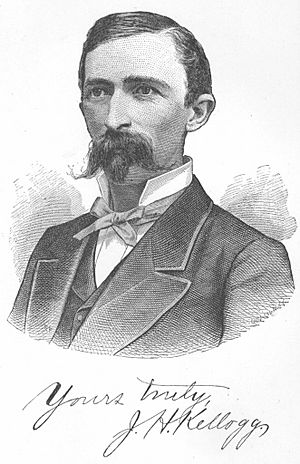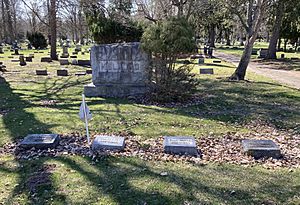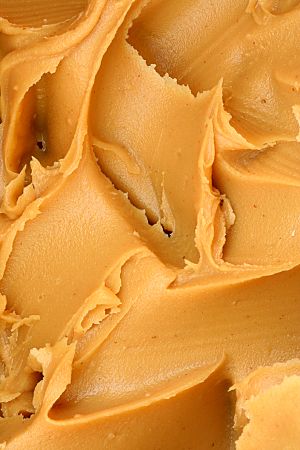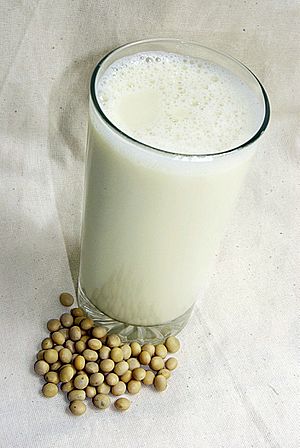John Harvey Kellogg facts for kids
Quick facts for kids
John Harvey Kellogg
|
|
|---|---|
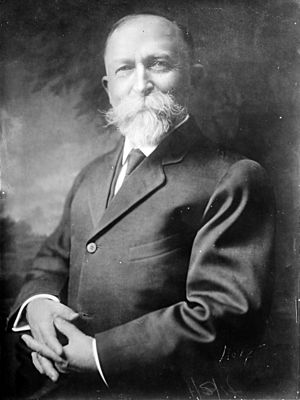
Kellogg around 1913
|
|
| Born | February 26, 1852 |
| Died | December 14, 1943 (aged 91) |
| Alma mater | New York University Medical College at Bellevue Hospital (M.D., 1875) |
| Occupation | Physician, nutritionist |
| Spouse(s) | Ella Ervilla Eaton (1853–1920), married 1879 |
| Children | 8 adopted |
| Relatives | Will Keith Kellogg, brother |
John Harvey Kellogg (February 26, 1852 – December 14, 1943) was an American doctor, nutritionist, and inventor. He was also a health activist and businessman. He is best known for directing the Battle Creek Sanitarium in Battle Creek, Michigan. He also helped invent the famous breakfast cereal, corn flakes, with his brother, Will Keith Kellogg.
The Battle Creek Sanitarium was started by members of the Seventh-day Adventist Church. It was like a European spa, a water therapy center, a hospital, and a fancy hotel all in one. Kellogg treated both rich and famous people, as well as those who couldn't afford other hospitals. He led the sanitarium until he died in 1943.
Kellogg was a big leader in health reform. He wrote many books and articles about science and health. His idea of "biologic living" mixed scientific knowledge with his religious beliefs. He promoted healthy living for everyone.
He was one of the first to believe in the germ theory of disease. This was a new idea that tiny germs cause sickness. He also understood early on how bacteria in the intestines affect health. The sanitarium used a holistic approach to health. This meant they focused on the whole person. They encouraged people to eat vegetarian food, exercise, get sunshine, use hydrotherapy (water treatments), and avoid smoking and alcohol.
Many of the vegetarian foods Kellogg created for his patients were later sold to the public. His invention of modern breakfast cereal changed how Americans ate breakfast forever.
Contents
Early Life and Education
John Harvey Kellogg was born in Tyrone, Michigan, on February 26, 1852. His parents were John Preston Kellogg and Ann Janette Stanley. John Preston Kellogg had 11 children with his second wife, Ann. These included John Harvey and his younger brother, Will Keith Kellogg.
His father became a member of the Seventh-day Adventist Church. In 1855, his family moved to Battle Creek, Michigan. They wanted to be near other members of their church. There, John Preston Kellogg started a broom factory.
The Kellogg family believed that formal education was not very important. So, John Harvey Kellogg only went to public school for a short time, from ages 9 to 11. He then left school to work in his father's broom factory. But he loved to read and learned a lot on his own.
When he was 12, John Harvey Kellogg started working for Ellen G. White and her husband, James Springer White. They were important leaders in the Seventh-day Adventist Church. He started as an errand boy and worked his way up to proofreading and editing. He helped prepare articles for health magazines. This is how he learned about Ellen G. White's health ideas. He also started following a vegetarian diet.
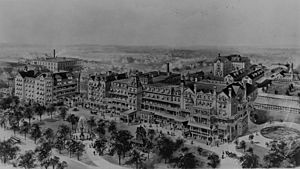
Kellogg wanted to be a teacher. At age 16, he taught at a school in Hastings, Michigan. Later, he enrolled in a teacher's training course. But the Whites convinced him to study medicine instead. They wanted trained doctors for their health institute in Battle Creek.
John Harvey Kellogg went to medical school at the University of Michigan. He also studied at the Bellevue Hospital Medical College in New York City. He earned his medical degree in 1875. In October 1876, Kellogg became the director of the Western Health Reform Institute. In 1877, he changed its name to the Battle Creek Medical Surgical Sanitarium. He made up the word "sanitarium" to mean both a hospital and a place for health and cleanliness. Kellogg led this institution until he passed away in 1943.
John Harvey Kellogg married Ella Ervilla Eaton in 1879. They did not have any biological children. However, they were foster parents to 42 children and legally adopted 8 of them. Ella died in 1920.
In 1937, Kellogg received an honorary degree from Oglethorpe University. This degree recognized his public service.
The famous historian Will Durant called Dr. Kellogg his "old mentor." Durant said that Dr. Kellogg had influenced his life more than almost anyone else.
Kellogg died on December 14, 1943, in Battle Creek, Michigan. He was buried in Oak Hill Cemetery.
Breakfast Cereals
Around 1877, John H. Kellogg started trying to make a softer breakfast food. He wanted something easy to chew. He created a dough from wheat, oats, and corn. He baked it for a long time at high temperatures. This process broke down the starch in the grains. After it cooled, Kellogg broke the bread into crumbs.
This cereal was first called "Granula". But this caused problems with James Caleb Jackson, who already sold a wheat cereal with that name. So, in 1881, Kellogg changed the name of his cereal to "Granola". Patients at the Sanitarium used it first. Then, former patients started buying it. In 1890, John formed the Sanitas Food Company to make and sell food products.
The Kellogg brothers are most famous for inventing Corn flakes in 1894. In their first year, they sold thousands of pounds of flaked cereal. They called it "Granose". They kept experimenting with rice and corn, not just wheat. In 1898, they released the first batch of Sanitas Toasted Corn Flakes. A new version that lasted longer on shelves came out in 1902.
Will Kellogg wanted to add sugar to the corn flakes. But John did not agree. So, in 1906, Will started his own company, the Battle Creek Toasted Corn Flake Company. This started a long disagreement between the brothers. Will's company eventually became the Kellogg Company. John H. Kellogg was not allowed to use the Kellogg name for his cereals.
John Harvey Kellogg was added to the National Inventors Hall of Fame in 2006. This was for his discovery of tempering and inventing the first dry flaked breakfast cereal. This invention "transformed the typical American breakfast."
Peanut Butter
John H. Kellogg is one of several people given credit for inventing peanut butter. A type of nut butter, probably made from peanuts, was served to patients at the Battle Creek Sanitarium before October 1895. At that time, Kellogg wrote that "excellent preparations from nuts" had completely replaced butter.
Kellogg did not patent peanut butter. He later said he did this on purpose. He wanted everyone who wanted it to be able to make and use it. However, Kellogg did apply for two patents related to "nut butters" in 1895.
By 1898, the Kelloggs were selling many different nut-based foods through their Sanitas Nut Food Company. Kellogg sold nut butters as a healthy protein substitute. It was for people who had trouble chewing solid food. Peanuts were the cheapest nuts available. Because of this, peanut butter quickly became very popular.
Other Foods
Besides making meat substitutes from nuts, grains, and soy, Kellogg also developed the first acidophilus soy milk. He patented this in 1934. Kellogg also sold yogurt, soy flour, and soy bread.
In 1896, J. H. Kellogg introduced "Nuttose." This was the first meat alternative sold commercially. Nuttose was mostly made from peanuts. It looked like "cold roast mutton" (lamb meat). By adding spices or marinades, Nuttose could taste like fried chicken or barbecue. Served with mashed potatoes and vegetables, it could be like a traditional American meal.
On March 19, 1901, Kellogg received the first U.S. Patent for a "vegetable substitute for meat." This was for a mix of nuts and grain cereals called "Protose."
Images for kids
-
Battle Creek Medical Surgical Sanitarium before 1902
See also
 In Spanish: John Harvey Kellogg para niños
In Spanish: John Harvey Kellogg para niños


